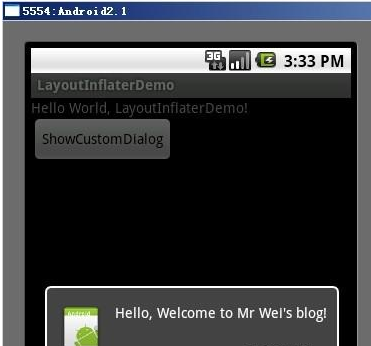在 实际开发中
LayoutInflater
这个类还是非常有用的,它的作用类似于findViewById()。不同点是LayoutInflater是用 来找res/layout/下的xml布局文件,并且实例化;而findViewById()是找xml布局文件下的具体widget控件(如 Button、TextView等)。
具体作用:
1、对于一个没有被载入或者想要动态载入的界面,都需要使用LayoutInflater.inflate()来载入;
2、对于一个已经载入的界面,就可以使用Activiyt.findViewById()方法来获得其中的界面元素。
LayoutInflater 是一个抽象类,在文档中如下声明:
publicabstractclass LayoutInflater extends Object
获得 LayoutInflater 实例的三种方式
1.LayoutInflater inflater = getLayoutInflater(); //调用Activity的getLayoutInflater()
2.LayoutInflater localinflater =(LayoutInflater)context.getSystemService
(Context.LAYOUT_INFLATER_SERVICE);
3. LayoutInflater inflater = LayoutInflater.from(context);
其实,这三种方式本质是相同的,从源码中可以看出:这三种方式最终本质是都是调用的Context.getSystemService()。
下面是一个Demo 定义对话框的布局方式 custom_dialog.xml
Activity代码

具体作用:
1、对于一个没有被载入或者想要动态载入的界面,都需要使用LayoutInflater.inflate()来载入;
2、对于一个已经载入的界面,就可以使用Activiyt.findViewById()方法来获得其中的界面元素。
LayoutInflater 是一个抽象类,在文档中如下声明:
publicabstractclass LayoutInflater extends Object
获得 LayoutInflater 实例的三种方式
1.LayoutInflater inflater = getLayoutInflater(); //调用Activity的getLayoutInflater()
2.LayoutInflater localinflater =(LayoutInflater)context.getSystemService
(Context.LAYOUT_INFLATER_SERVICE);
3. LayoutInflater inflater = LayoutInflater.from(context);
其实,这三种方式本质是相同的,从源码中可以看出:这三种方式最终本质是都是调用的Context.getSystemService()。
下面是一个Demo 定义对话框的布局方式 custom_dialog.xml
Activity代码
运行效果:





 本文详细介绍了LayoutInflater类的作用及使用方法,展示了如何通过LayoutInflater加载XML布局文件并实例化,对比了与findViewById的区别,提供了具体的代码示例。
本文详细介绍了LayoutInflater类的作用及使用方法,展示了如何通过LayoutInflater加载XML布局文件并实例化,对比了与findViewById的区别,提供了具体的代码示例。
















 2327
2327

 被折叠的 条评论
为什么被折叠?
被折叠的 条评论
为什么被折叠?








